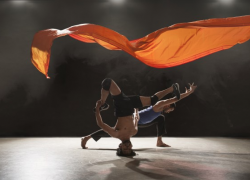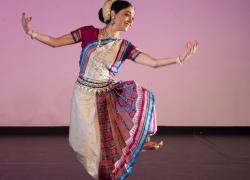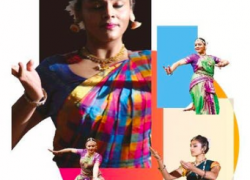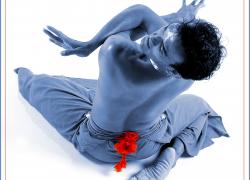Dancing Nation
Dancing Nation
Sadler’s Wells & BBC Arts
28 January – 26 February 2021
Reviewed by the Pulse Dance Club
24 February 2021
These three films have been made ‘to celebrate all of the dance that is happening across our nation at the moment’ (Alistair Spalding, Artistic Director of Sadler’s Wells). Dance lovers often tend to see only their preferred genre or style, but this initiative has provided audiences with an opportunity to experience dance new to them, albeit on a small screen.
Dance writer and Guardian dance critic Sanjoy Roy was invited to lead the discussion. His opening remark encouraged members to voice their opinions: 'There is no right answer, all opinions are equally valid – impressions, half-formed ideas are fine too.'
The group picked out some highlights. Spitfire (1988, choreography by Matthew Bourne) ‘kept me laughing the whole time… Men’s vanity, men’s egos, there it is, all there on the stage, in underwear.’ It was clever, camp and funny, though to some it started to feel indulgent: ‘After the initial joke, I wanted it to move on and develop a bit.’
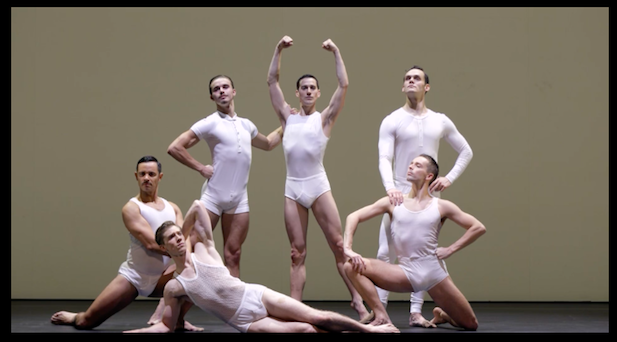
Face In by Candoco Dance, the company of disabled and non-disabled dancers, made a strong impression. This was ‘unpredictable, attractive, sexy', with 'electric colours', even though ‘it didn’t all tie up’ and some would have liked more flow and interaction. ‘The definition of dance has changed for so many people’. It made us think differently about dance and bodies.
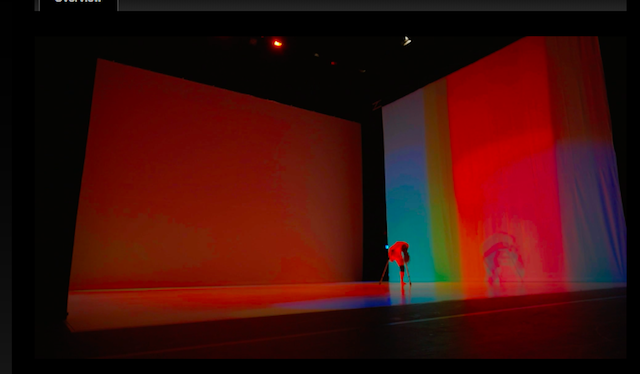
Window Shopping, curated by Breakin’ Convention, was playful and polished. It was cleverly filmed in the spaces of Sadler’s Wells, the foyers and staircases, sometimes from outside the windows, presenting the contrasting dance and music for which audiences go to Sadler’s Wells.
‘I was sucked into the drama of Hollow’ (English National Ballet). There was some discussion of the roles, with the woman overcome by depression held up by the man, who wants to help but cannot; and of how these compared with the roles in Touch (see below). Here there was more of a female perspective. The music was mentioned, particularly the cellos, which became very violent and discordant.
Far From The Norm’s BLKDOG (choreographed by Botis Seva) stood out for the group. ‘I was spellbound’ – ‘the way they scurried across the stage on their toes, like little insects’, ‘phenomenal ensemble work’. It was ‘dystopian, dark and demoralising’ but ‘drew one in in unexpected ways’. ‘I saw images of Guantanamo, of Abu Ghraib, of people in prison’. The close-ups heightened the experience, although ‘I would have loved to be in the theatre, feeling the sound as well as watching’.
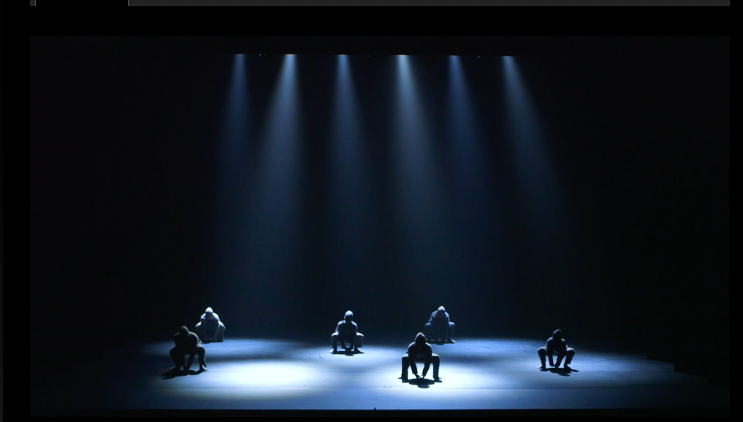
Hope Hunt and the Ascension into Lazarus (choreography by Oona Doherty) set in Belfast drew divergent responses: ‘I felt my age. It was about another angry teenager, but I’ve seen all this for so many decades and generations. It’s more for younger people.’ But it was a stand-out piece for others, drawn to the challenge and to the opportunity to meet such characters.
Mud of Sorrow: Touch (Akram Khan and Natalia Osipova) found the members sharply divided. Some were very moved – by the touch, contrasting with the lack of it in the hip hop pieces; the tenderness; the maturity; the connection between the two dancers and the skill of the choreography: ‘Osipova pirouettes around the stage (pure virtuosity), and ends in a slow-dance hold with Akram like an ordinary couple on the dance floor.’ Others, however, were less impressed. The role of the woman was a particularly contentious issue. It was ‘uncomfortably like a male fantasy’, with Osipova disappearing as in a dream. It was felt also that ‘kathak’ had been over-emphasised in the publicity as it raised expectations that were not to be fulfilled.
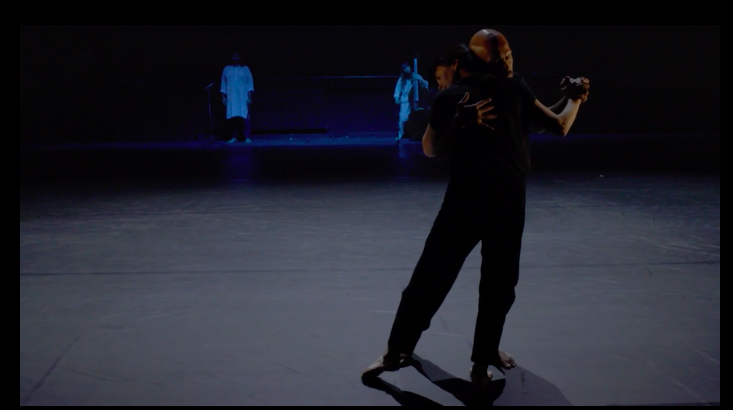
Shades of Blue (Matsena Productions) demonstrated the drama of hip hop work and made a strong impression. It was a commentary on the past year, with ‘wonderful storytelling quality’. It was ‘expressive, moving and emotional’. The images remained with the viewer – of hands behind backs, a single body, a line of policemen. The script, towards the end, was also strong.
Those who watched as far as Contagion (Shobana Jeyasingh Dance), found it powerful. ‘I was moved by the opening, the combination of words and Greek chorus-like images’.
Some of the ballet pieces generated less discussion, but the beauty of the lighting, the projections and the skies of Birmingham Royal Ballet’s Lazuli Sky were appreciated. It was ‘cheering to see Rambert again’; Rouge used a ‘completely different movement quality’.
HUMANHOOD were able to provide a verbal programme note as they had more time than others to talk about their pieces, Orbis and Sphera and about the creative process. Some struggled with these works and found the coat-flapping irritating; but ‘the duo in HUMANHOOD moved like water, in constant flow’; and there was a comment that theirs was the aesthetic that challenged the aesthetic vision governing the films.
Hip hop, with its black roots, was strongly represented. There was, however, disappointment at the omission of any South Asian dance. Without this, the programme wasn’t ‘all of the dance that’s happening’.
The group enjoyed the range and the exceptional quality of the dancing, whether abstract, formal, narrative or emotive. Much depends on mood at the time of viewing, or indeed one’s stage in life. Some wanted simply beauty, or perhaps melancholy, but nothing grim. Others felt in need of a journey, a story. Another wanted to let go of any intellectual baggage and to ‘go with the flow’. The electronic scores and mixes worked well with many of the new choreographies.
One advantage of filmed works is that it’s possible to re-view and also to skip. The films have been made available for a month, but they would be watched again if they were made available for longer. Twelve of the films can still be watched online on the Sadler’s Wells website.
Images are screenshots from the films.
With thanks to Sanjoy Roy for leading the discussion with Sanjeevini Dutta and to the participants: Bisakha Sarker, Coralie Green, Debbie Williams, Elena Catalano, Kate Stein, Magdalen Gorringe and Patricia Morison. Compiled by Gopa Roy.
The letter below was sent on 1 March 2021 to -Feedback @Sadler’s Wells, copy to Editor @Pulse
Dear Britannia,
Thanks to all at Sadler's Wells for the wonderful three-part series Dancing Nation which brought some much needed beauty to a cold (and in many ways bleak) February. We enjoyed watching familiar artists and discovering new ones – and really appreciate the efforts that the artists and all the staff and Sadler’s must have taken to get this event together in the midst of all the Covid restrictions.
We do have one disappointment however which we felt we had to share. Though Dancing Nation aims to ‘celebrate all the dance that is happening across our nation at the moment’ presenting ‘dance in all its forms…as a testament to the extraordinary range and diversity of work being presented across the UK’, it didn’t feature much South Asian dance – and we think this was a great loss. We appreciate that Akram and Shobana draw on kathak and bharatanatyam respectively – and we think both Mud of Sorrows and Contagion are beautiful and moving pieces. However, the direction in which the creative exploration of these choreographers has taken them means that their work no longer always focuses on the aesthetics and vocabulary of South Asian dance forms – certainly we did not feel that South Asian dance was represented by either of these pieces. This felt to us a significant gap – we wished that you could have presented one of the many wonderful artists in the UK whose work remains more fully rooted in the South Asian forms (or indeed a work by Akram or Shobana that is more evidently grounded in kathak/BN). For us as practitioners, it is really painful that the wealth and depth of our art forms do not have a representation in the 'nation'.
We feel this is particularly important because there are hundreds of children and young people across the country who go to Bn/ kathak/odissi classes each week and we think it would mean a huge amount to them to see their art forms represented as part of Dancing Nation. As it is we don’t think the average BN/ kathak/ odissi student would recognise their dance forms in this series – which is just such a shame. As the popular slogan puts it, ‘you have to see it to be it’, and we don’t think that in the current program they ‘see it’. Akram is a fantastic role model, but probably the take home message they would get from this particular piece (Mud of Sorrows) is that they need study (western) contemporary dance. We think that it is really important for these young dancers (as well as for dance in this country) that efforts are made to address the divide there currently is between ‘community dance’ in ‘community spaces’ and primarily Western contemporary informed dance in the mainstream theatres. If this does not happen (and the onus most rest, we believe, on the larger organisations to drive this), the world of classical practice of South Asian dance forms in the U.K will be increasingly divorced from the wider world of British dance, to the detriment of both. Sadler’s has already taken a lead in addressing similar divides with Breakin’ Convention. It was great to see the inclusion of so much hip hop in Dancing Nation – could we have more South Asian dance please?
Once again, many thanks for all your work on this wonderful series. We hope it can be repeated (even out of lockdown) and we really hope that more kathak/bharatanatyam/odissi dance can be featured when it is.
Yours sincerely
Magdalen Gorringe (PhD researcher, University of Roehampton) and Dr Elena Catalano (Dancer and Anthropologist, Kingston University of London)
















